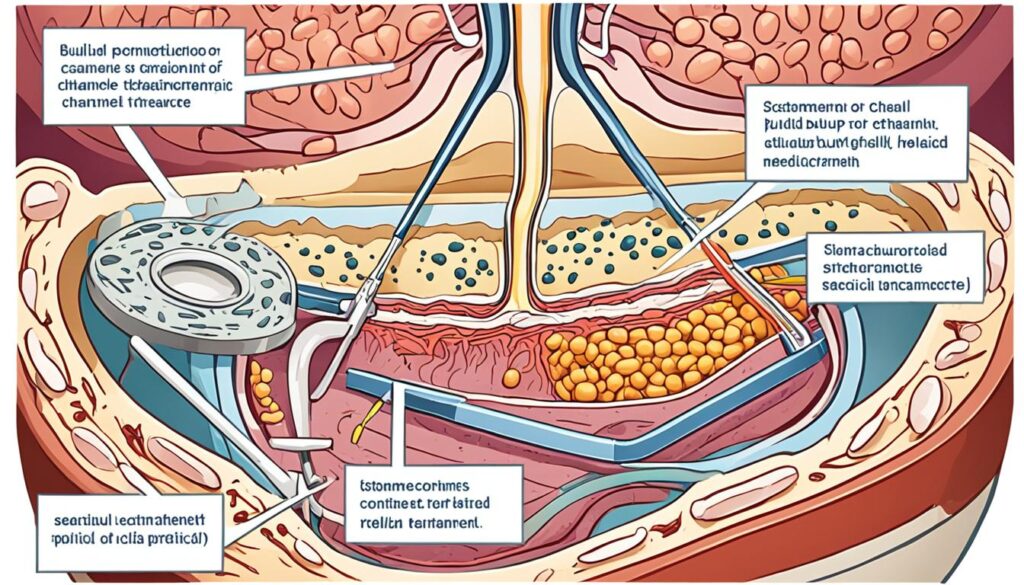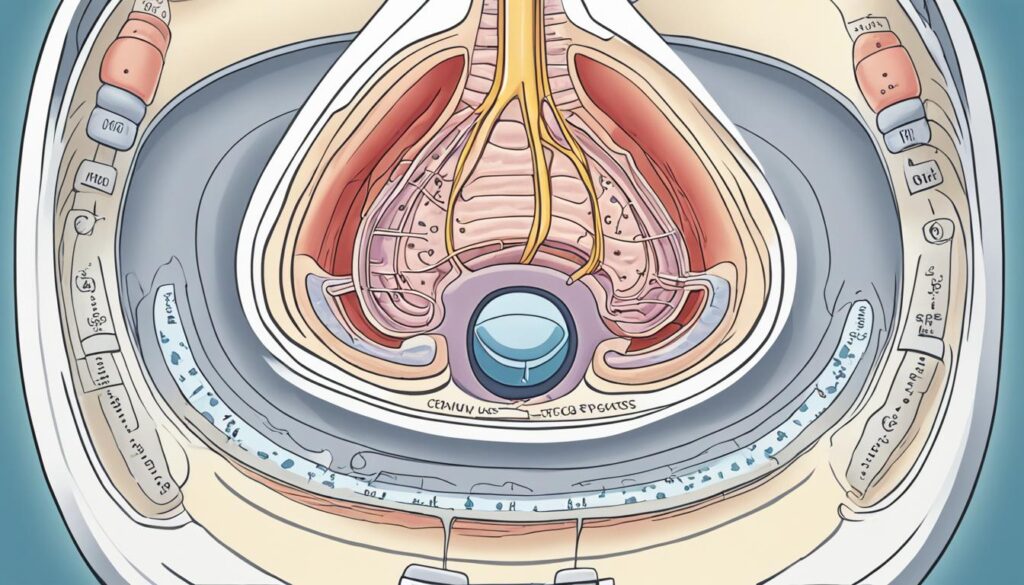If your baby has pyloric stenosis, understanding its treatment is vital. This issue happens when the valve between the stomach and small intestine is blocked. Your child might face difficulties eating and digesting food. The good news is, this problem can be solved.
Table of Contents
ToggleThe main treatments for pyloric stenosis are medical care and surgery. Your doctor will choose what’s best for your baby. This decision depends on how serious the problem is and your baby’s health. Being aware of these options helps you support your child’s care effectively.
Understanding Pyloric Stenosis
Pyloric stenosis is rare but affects infants, mainly in their first months of life. It happens when the pylorus, a muscle valve between the stomach and the small intestine, gets too thick and narrow. This makes it hard for food to pass, leading to the baby vomiting often.
What is Pyloric Stenosis?
This condition targets the pylorus, a valve controlling food’s path from the stomach to the intestines. In some babies, this valve thickens and narrows, stopping food and causing strong vomiting.
Causes and Risk Factors
The cause of pyloric stenosis isn’t all clear, but experts think genes and the environment play a role. Being male, the first child, and of certain ethnicities can increase your risk. Smoking during pregnancy and some antibiotics for babies might also play a part.
Signs and Symptoms
The main symptom is forceful vomiting, which can start when the baby is 2-8 weeks old. This vomiting is so strong it shoots out of the mouth. Babies might also have other signs like not gaining weight, constipation, or a hard stomach.
Without treatment, pyloric stenosis can cause serious problems. These include not growing properly, dehydration, stomach issues, and jaundice.

Diagnostic Procedures
The first step in diagnosing pyloric stenosis involves a thorough checkup. The healthcare provider will carefully feel your baby’s tummy. They’re looking for a bulge called the “olive-shaped” mass. This mass is from the pylorus muscle being too thick.
Sometimes, the provider can see the stomach move. They notice this as waves going across your baby’s tummy.
Blood Tests
Your provider might also ask for blood tests. These tests check your baby’s fluid and electrolyte levels. Pyloric stenosis can cause problems like dehydration. It also messes with electrolytes, causing low potassium and high bicarbonate levels.
If a baby has pyloric stenosis, these blood tests help know how severe it is. They’re key for choosing the right treatments.
Ultrasound Imaging
Ultrasound is the main way to confirm pyloric stenosis. Using sound waves, a technician will check the pylorus. They look at how thick and long the muscle is, and the size of the stomach’s opening. Comparing these findings with normal measurements helps diagnose pyloric stenosis.
X-ray Imaging
Some cases might need an x-ray too. It’s called an upper GI series or a barium swallow. Here’s how it works: your baby drinks a liquid that shows up on x-ray. This helps spot pyloric stenosis.

Medical Management
First off, managing pyloric stenosis starts with giving IV fluids. This is for infants since they can get dehydrated and lose important body salts from all the vomiting. Fixing this is vital before any surgery.
Intravenous Fluid Replacement
The main aim of IV fluid therapy is to fix the fluids and salts balance. This makes the baby ready for any needed surgery. The medical team keeps an eye on how much fluid the baby gets and its effect by checking lab values.
Atropine Therapy
In certain situations, doctors might try a drug called atropine first. Atropine helps the stomach muscle relax, making it easier for food to go through. But, it doesn’t always work, especially for severe cases. So, the doctors will watch how the infant reacts to atropine. This decides if the baby needs surgery.

Surgical Treatment: Pyloromyotomy
The go-to surgery for pyloric stenosis is pyloromyotomy. This surgery is key for fixing the problem by clearing the way between the stomach and small intestine. It targets the pylorus, which is a tiny but important muscle valve.
Open Pyloromyotomy
In open pyloromyotomy, a skin cut is made on the belly. The thickened pylorus muscle is then cut. This lets the inner wall of the pylorus stick out, making room for food to go through. Open pyloromyotomy has been the main way to treat pyloric stenosis for a long time.
Laparoscopic Pyloromyotomy
Laparoscopic pyloromyotomy is a newer, less invasive method. It uses a small camera and thin tools to do the surgery through tiny cuts. These cuts are usually around the baby’s belly button. The benefits include a faster recovery and smaller scars.
Postoperative Care and Recovery
After surgery, babies are closely watched in the hospital for up to a day. Health professionals watch their progress. They start giving fluids through a vein, then feed the baby again. They also give pain relief and keep an eye out for any rare issues like bleeding or infection.
Most babies do well after surgery. They can eat and grow like other babies do.
Comparing Open and Laparoscopic Approaches
The open and laparoscopic approaches both work well for treating pyloric stenosis. However, they have some differences. It’s important to look at these when choosing surgery.
The open pyloromyotomy means making a big cut in the belly to reach the blockage and fix it. This method has been used for a long time. On the other hand, the laparoscopic method is less invasive. It uses tiny cuts and special tools to do the same job.
The laparoscopic surgery takes less time, usually 21 minutes versus 30 for open surgery. This means a faster recovery and less chance of problems after.
Babies who have laparoscopic surgery feel less pain after. They need less medicine for the pain. They start eating normally and leave the hospital sooner too, usually within 19 hours.
But, the laparoscopic way might have some issues. Sometimes the doctor might need to switch to the open surgery. This happens in about 5% of cases. It could be due to small cuts not reaching the blockage fully or other issues.
So, choosing the right surgery is complex. It depends on the baby’s condition and the doctor’s skills. Both ways have good and bad points to think about. Careful thought and experienced doctors are important for the baby’s surgery success.

Complications and Risk Factors
The pyloromyotomy surgery is usually safe and works well. But like any surgery, there are risks. Complications may include infections, bleeding, or needing more surgery if the pylorus muscle isn’t cut fully.
Postoperative Complications
In rare cases, there can be issues after surgery. This includes slow stomach emptying, the wound opening, or a condition called “dumping syndrome.” Dumping syndrome can cause quick food movement from the stomach to the small intestine. This leads to diarrhea, nausea, and belly pain.
Risk Factors for Prolonged Hospitalization
Sometimes, certain things can make the hospital stay longer. This includes being born early, having other health issues, or requiring more treatments. These issues can slow down recovery and increase the time spent in the hospital.
Preparing for Pyloric Stenosis Treatment
The healthcare team is here to help you prepare for your child’s pyloric stenosis treatment. They will make sure your baby is ready for surgery and can recover well. This includes a few important steps:
- Fluid and Electrolyte Replacement: Your baby might be dehydrated and have electrolyte problems from vomiting. Doctors will give IV fluids and watch your baby’s electrolytes.
- Nutritional Support: If needed, the team will stop oral feeding. They’ll give nutrients through an IV or a feeding tube. This ensures your baby’s ready for surgery.
- Diagnostic Imaging: Additional tests like ultrasound or X-rays are done. They help confirm the diagnosis and plan the surgery.
- Surgical Consultation: You will meet the surgeon before surgery. The surgeon will explain the operation, answer questions, and talk about recovery.
The team prepares your child to have the best surgery and recovery possible. Knowing what to expect before pyloric stenosis surgery helps calm your family and prepares you for a good outcome.
Pyloric Stenosis Treatment in Newborns
Pyloric stenosis can happen in newborns just a few weeks old. It’s key to spot and treat this early. The method to deal with pyloric stenosis in newborns is much like in older babies, but there are some extra things to think about.
For babies, a good look and some tests are vital to figure out if they have pyloric stenosis. The doctors will check the baby’s belly for a bulge that feels like an olive pit. They might also do blood tests to see if the baby needs more fluids or has too much of certain minerals.
When doctors confirm the pyloric stenosis, they usually opt for surgery. In newborns, this surgery might happen the very same day. The medical team will make sure the baby is well enough for the surgery. They’ll also check that the baby is drinking enough and is stable.
After the surgery, babies may need IV fluids for a short time. They can start feeding again within a day. They might eat a lot more and still throw up for a few days. But, this is often part of getting better and usually calms down on its own.
Most of the time, pyloric stenosis surgery works well in newborns. Yet, the doctors will keep a close eye on the baby for possible issues like bleeding or infections, which are not common but could happen. With quick diagnosis, the right treatment, and a skilled operation, babies with pyloric stenosis usually get better quickly. They go back to eating and digesting like they should.
Surgeon Experience and Outcomes
The skill and experience of the surgeon treating pyloric stenosis matter a lot. A study showed that the time a surgery took could drop a lot with more skilled surgeons. For example, the first surgery in one study took 110 minutes. But by the time they reached the 35th surgery, it only took 35 minutes.
So, as surgeons get better at a surgery, they can do it faster. In another study, the time for a surgery went from 110 minutes to just 32 minutes as the surgeon became more skilled. This means patients might do better with more experienced surgeons.
One case in a study had to switch from laparoscopic to open surgery because of difficulties. This shows how important it is for surgeons to be very skilled. With a difficult surgery like this, an experienced surgeon can handle surprises better.
FAQ
What is pyloric stenosis?
What causes pyloric stenosis?
What are the symptoms of pyloric stenosis?
How is pyloric stenosis diagnosed?
How is pyloric stenosis treated?
What is a pyloromyotomy?
What are the potential complications of pyloric stenosis surgery?
How can I prepare my infant for pyloric stenosis treatment?
Are there any unique considerations for treating pyloric stenosis in newborns?
How does the surgeon’s experience impact the outcomes of pyloric stenosis treatment?
Source Links
- https://www.mayoclinic.org/diseases-conditions/pyloric-stenosis/diagnosis-treatment/drc-20351421
- https://emedicine.medscape.com/article/937263-treatment
- https://www.ncbi.nlm.nih.gov/pmc/articles/PMC8392573/
- https://www.hopkinsmedicine.org/health/conditions-and-diseases/pyloric-stenosis
- https://www.cincinnatichildrens.org/health/p/pyloric-stenosis
- https://www.mayoclinic.org/diseases-conditions/pyloric-stenosis/symptoms-causes/syc-20351416
- https://www.ncbi.nlm.nih.gov/books/NBK555931/
- https://emedicine.medscape.com/article/803489-treatment
- https://pubmed.ncbi.nlm.nih.gov/27521712/
- https://www.nature.com/articles/s41598-019-57031-4
- https://www.ncbi.nlm.nih.gov/pmc/articles/PMC7475708/
- https://scholarlyexchange.childrensmercy.org/cgi/viewcontent.cgi?article=1582&context=papers
- https://www.ncbi.nlm.nih.gov/pmc/articles/PMC7729719/


